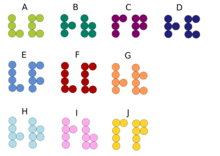IQ Fit
IQ Fit is a puzzle game in which ten pieces of different shapes have to be placed seamlessly in a playing field consisting of 50 equally sized depressions arranged in a grid. It is a geometric puzzle from the field of entertainment mathematics .
Game components
Game pieces
All ten puzzle pieces are made up of individual, tightly interconnected small spheres (spherical diameter approx. 1 cm).
Four of them consist of six balls each and are about 3 cm long, the rest are about 4 cm long and each consist of seven balls.
For each piece, three or four of these balls are lined up closely in one direction (this results in their above-mentioned length of 3 cm or 4 cm). Another ball is attached to the side of each ball of this row of balls (and lies with the balls of the row of balls in the same plane (A)), two further balls are also (individually) attached to any ball of the same row of balls on one side, but so that they lie with it in a plane (B) perpendicular to plane A.
This structure of the ten puzzle pieces means that each piece can be 'anchored' firmly in the holes of the playing field with one or the other two laterally protruding balls. The side balls (two or one) not used for this purpose are then automatically placed with the row of 3 or 4 balls in the desired playing field level and thus form the actual game piece. Each puzzle piece can therefore be used in two versions (A or B) to put together a puzzle (see adjacent sketch).
matchfield
The playing field has a size of about 6 * 12 cm². The 50 holes are arranged in 5 rows of ten. Each piece is inserted in such a way that the single ball or the two single balls of the piece point downwards and can be inserted into the holes in the playing field. Depending on the size and position of the stone, there are four to six individual balls on the playing field level.
Tasks of the booklet
In an accompanying booklet, the position of individual stones in the playing field is given for 120 puzzles. When specifying z. B. seven or eight pieces, it is relatively easy for the player to insert the remaining three or two pieces correctly, but the level of difficulty increases up to the specification of only two pieces.
According to the booklet, there is exactly one correct solution for each of the 120 tasks; this is given at the end of the booklet.
Combinations with ten pieces
With the 120 tasks and solutions mentioned in the booklet, the possible variations of the puzzle are by no means exhausted. Computer calculations show that there are a total of 310,350 different solutions using all ten pieces (two solutions that are converted into themselves by rotating the playing field by 180 ° are counted as two solutions).
Combinations with nine pieces
IQ Fit consists of four small and six large game pieces. For the small stones, version A has four and version B five balls for the puzzle, for the large stones there are five balls for version A and six balls for version B. The 'minimum number' of puzzle balls for an (incomplete) puzzle image is therefore (4 * 4) + (6 * 5) = 46 balls, the maximum supply is (4 * 5) + (6 * 6) = 56 balls. If you leave out one of the large pieces, there are still exactly 50 balls available for the puzzle if each of the nine remaining pieces is used in version B. On the other hand, if you leave out a small piece, a maximum of 51 balls are available, so the smaller version A must be used for one of the pieces involved in the puzzle.
From a purely arithmetical point of view, the playing field can also be completely filled with just 9 pieces, but this has not yet proven whether this is also practicable; However, corresponding calculations have shown that such a puzzle is also possible and that any game piece can be left out. For the remaining nine pieces there are several options for filling the playing field without gaps, there are a total of 810 solutions (two solutions that are converted into themselves by rotating the playing field by 180 ° are counted as two solutions).
In the booklet it is not mentioned that there are also solutions with nine tiles.
statistics
The following statistics relate to the set of all possible solutions (not just those in the booklet).
Ten game pieces
The graphic on the right shows that version A is used significantly more often than version B for some game pieces, whereas version B is only used slightly more often than version A in the opposite case.
Nine game pieces
The 810 possible puzzle images result from the assumption that all ten pieces are available to assemble the respective puzzle, but one of them is not used.
The graphic on the right shows that the lower version A of each piece is rarely used, in most cases the piece that is not used is a small piece (A, B, C, D)
Awards
In 2012 IQ Fit received the "Parents Choice Silver Award".





